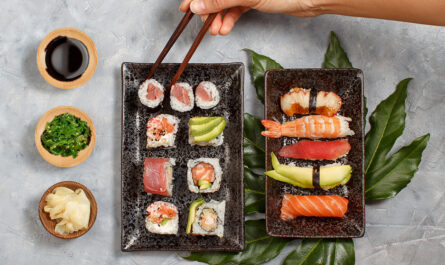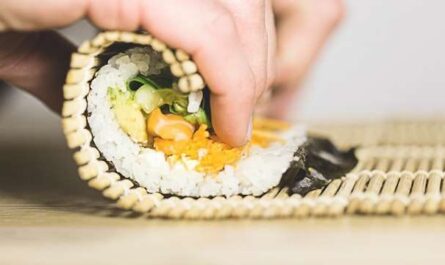If you’re a fan of sushi but are looking for a substitute for sushi rice, you’ve come to the right place. Whether you’re driven by dietary needs, an adventurous palate, or simply curiosity, finding the right alternative can still satisfy your sushi cravings. Let’s dive into the world of delicious possibilities.

Understanding Sushi Rice
Before we explore substitutes, it’s essential to understand what makes traditional sushi rice unique. Typically, sushi rice is a short-grain rice known for its sticky texture, which is crucial for holding the sushi together. The rice is usually seasoned with a mix of rice vinegar, sugar, and salt, giving it its distinctive flavor.
Characteristics of Sushi Rice
Traditional sushi rice, often referred to as shari or sumeshi, contains a balance of sticky and fluffy textures, enabling the formation of sushi rolls and nigiri. The seasoningan art in itselfcontributes to its refreshing flavor that pairs harmoniously with fresh fish and other ingredients.
Why Look for a Substitute for Sushi Rice?
There are various reasons why someone might look for a substitute for sushi rice. These can include:
- Dietary restrictions such as a gluten-free diet
- Low-carb or ketogenic dietary preferences
- Exploring different flavor profiles
- Lack of traditional ingredients
Keeping Sushi Balanced
Regardless of the substitute, maintaining the balance of sweet, sour, and umami flavors in sushi is critical. The chosen substitute should complement the other ingredients typically found in sushi.
Rice Alternatives
Several rice alternatives offer a fresh take on traditional sushi. Let’s explore some of the most popular and flavorful substitutes.
Cauliflower Rice
A great low-carb option, cauliflower rice can be seasoned similarly to sushi rice. Its neutral taste allows it to readily absorb the seasonings, making it a favorite among those following a ketogenic diet.
Quinoa
Quinoa is a protein-rich grain that’s packed with nutrients. With a slightly nutty flavor, it offers a unique twist on traditional sushi rice and works wonderfully in sushi bowls.
Brown Rice
Though less sticky than white sushi rice, brown rice provides a whole-grain alternative, rich in fiber. It’s essential to adjust the water content for the desired texture. Learn more about preparing brown rice here.
Forbidden Rice
Also known as black rice, this variety adds a pop of color and a nutty, sweet flavor to your sushi, making it visually appealing and nutritious.
Non-Rice Alternatives
Looking beyond grains, there are several other creative options for making delicious sushi.
Chickpea Mash
Mashing chickpeas and mixing them with classic sushi vinegar can create a creamy, protein-packed bed for sushi ingredients.
Quinoa and Lentil Mix
Mixing quinoa and lentils provides a protein-rich base with an exciting blend of textures that’s familiar yet delightfully different from rice.
Vegan and Gluten-Free Options
For those following a vegan and gluten-free diet, there are plenty of options that can cater to these needs while still offering a satisfying sushi experience.
Zoodles
Turn zucchini into spiralized zoodles for a light, gluten-free sushi option that pairs well with traditional sushi toppings.
Substitute in Different Sushi Dishes
Here are some ideas for using substitutes in various sushi dishes:
Sushi Rolls
Experimenting with different grains and alternatives can offer a whole new experience in sushi rolls. Whether using quinoa or cauliflower rice, remember to adjust the seasoning to highlight the natural flavors.
Sushi Bowls
Sushi bowls offer a deconstructed take on sushi, perfect for showcasing alternatives like black rice or a quinoa-lentil blend. This setup allows for the freedom to mix ingredients and flavors in unique ways.
Nigiri
While nigiri traditionally requires the stickiness of rice, experimenting with chickpea mash or another sticky alternative can provide an exciting new take.
Innovative Sushi Concepts
Today’s culinary scene has inspired home cooks and chefs alike to push the boundaries of traditional sushi, leading to innovative concepts using rice substitutes.
Exploring Sushi Traditions
In numerous cultures, sushi has many adaptations, some of which use native ingredients as substitutes for rice. These global interpretations offer a world of tastes to explore while respecting the essence of sushi.
Making the Transition Smooth
Transitioning to using rice substitutes can be seamless by maintaining balance and flavor in your sushi creations. Adjust the seasoning, add traditional toppings, and keep experimenting to find your preferred substitute.

Frequently Asked Questions
What can I use if I don’t have sushi rice?
Several alternatives can be used, such as quinoa, cauliflower rice, brown rice, or even black rice. Each presents distinct textures and flavors.
Is it possible to use regular rice as a substitute?
Although not ideal, regular white or brown rice can be used. However, you’ll need to adjust the water and seasoning accordingly to mimic the texture and taste of sushi rice.
Are there any vegan-friendly rice substitutes?
Yes, options like quinoa, lentils, and zoodles can cater to vegan dietary preferences while offering delectable flavors.
Always remember, when considering substitutes for sushi rice, creativity, and open-mindedness are key. By experimenting with different ingredients, you can discover that substitute for sushi rice that best suits your taste and dietary needs.
For more ideas and inspiration, consider checking resources on soaking sushi rice and understanding what is short-grain rice.
This article contains affiliate links. We may earn a commission at no extra cost to you.




